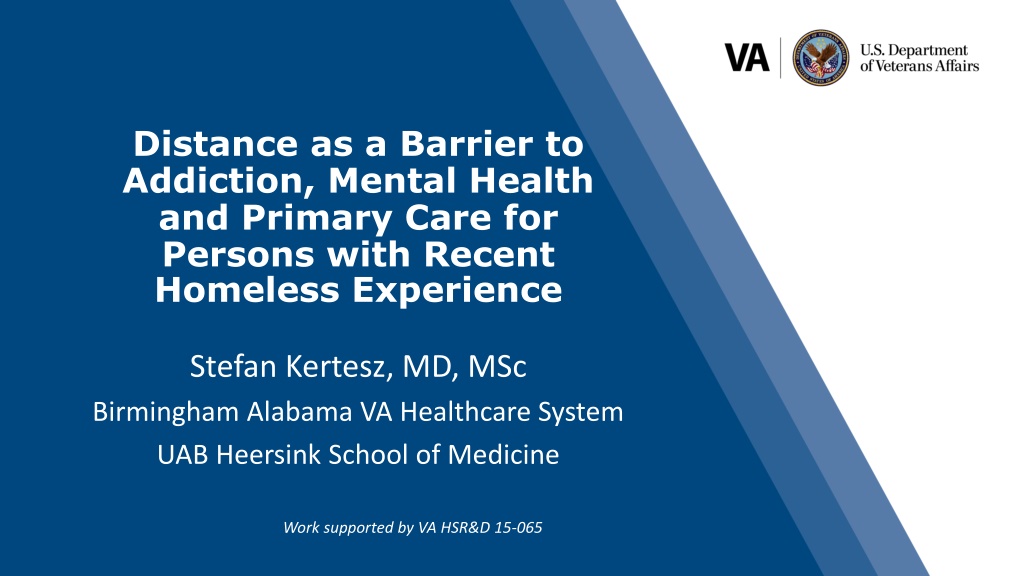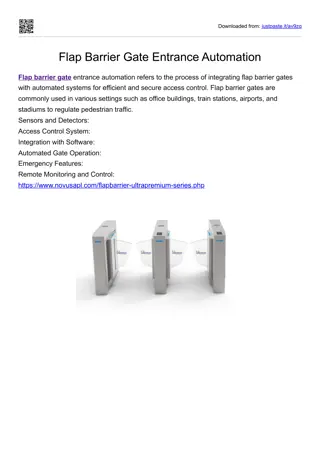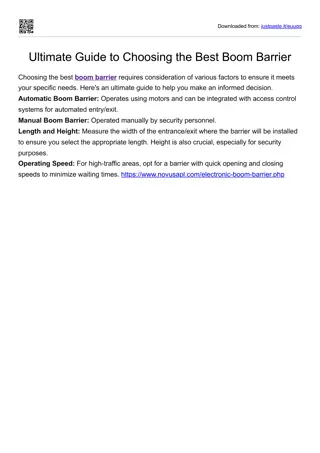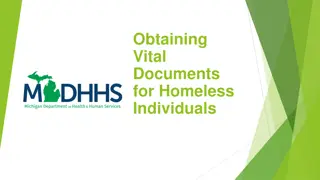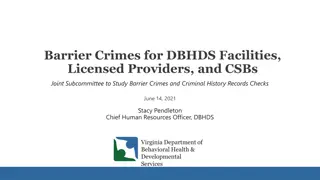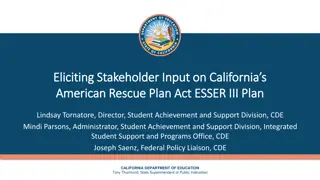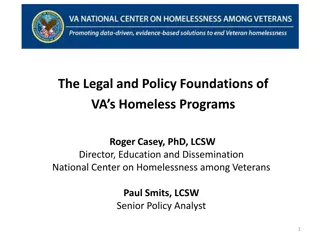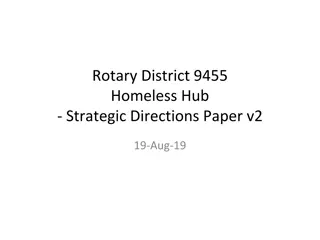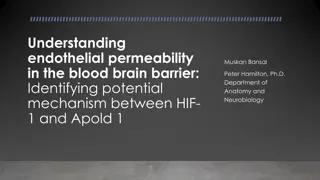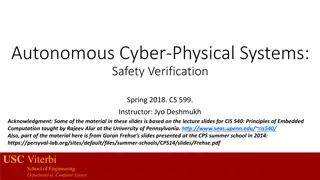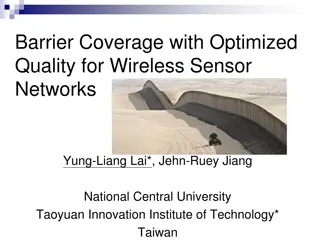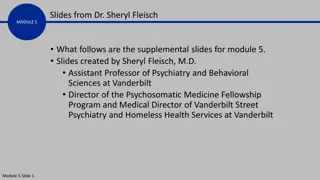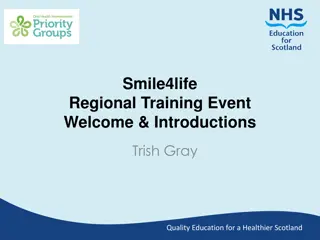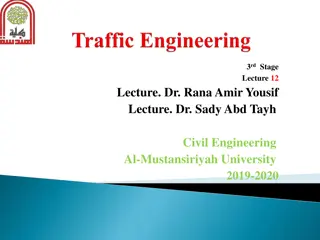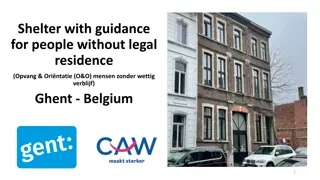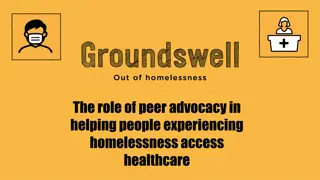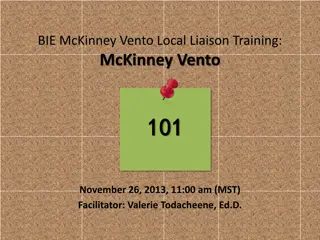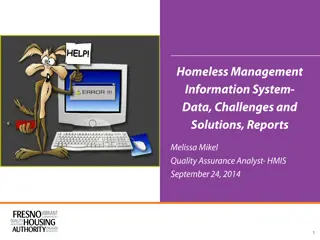Distance as a Barrier to Healthcare Access for Individuals with Recent Homeless Experience
The study explores the impact of geographic distance on healthcare access for individuals with recent homeless experience. It assesses the association between distance to VA facilities and perceived barriers to care, as well as the relationship between perceived distance barriers and utilization of primary care, mental health, and substance use disorder services over 12 months.
Download Presentation

Please find below an Image/Link to download the presentation.
The content on the website is provided AS IS for your information and personal use only. It may not be sold, licensed, or shared on other websites without obtaining consent from the author. Download presentation by click this link. If you encounter any issues during the download, it is possible that the publisher has removed the file from their server.
E N D
Presentation Transcript
Distance as a Barrier to Addiction, Mental Health and Primary Care for Persons with Recent Homeless Experience Stefan Kertesz, MD, MSc Birmingham Alabama VA Healthcare System UAB Heersink School of Medicine Work supported by VA HSR&D 15-065
Disclosures Funded by US Department of Veterans Affairs Health Services Research & Development Branch Views are those of the authors only Dr. Kertesz: royalties for editing the UpToDate chapter on Homeless Health Care from Wolters- Kluwer
3 Collaborators Birmingham VA & UAB VA Salt Lake City & UUtah VA Greater Los Angeles & UCLA Pittsburgh VA & Pitt Strategic Research Group (SRG) Tina Kassebaum (lead) Aerin deRussy April Hoge Adam Gordon Lillian Gelberg John Blosnich Erika Austin Allyson Varley Audrey Jones Sonya Gabrielian Ann Elizabeth Montgomery David Pollio Adi Gundlapalli Young-il Kim Kevin Riggs Sally Holmes Views do not represent formal positions of the United States Department of Veterans Affairs Dr. Kertesz: No pharmaceutical grants, honoraria, or history of such Previously owned stock in Abbot & Merck companies (<3% of assets), sold in 12/2017. Dr. Kertesz s wife has same + Johnson & Johnson, has not sold her stock.
4 Background For many homeless persons, ending homelessness entails Subsidized rental apartments Buttressed by services These are often in low-rent areas far frommedical centers Impact of distance on care access has not been studied for this population Distance can be objective or subjective, and both could matter
5 Objectives We examined whether 1. Geographic distance from residence to VA was associated with a Perceived Distance Barrier to care 2. A Perceived Distance Barrier was associated lower primary care (2A), mental health (2B) and SUD visits (2C) over 12 months
6 Methods Cross-sectional large survey Included: homeless-experienced Veterans (HEVs), primary care 26 VA medical centers, 2018 Data: Surveys + VA utilization database We focus here on 83% who affirmed not being homeless on survey date $10 gift card Up to 4 Up to 5 $1 Up to 98 items preincentive
7 Main Variables Hypothesis Outcome Predictor Perceived Distance Barrier Does the distance you have to travel make it difficult to receive care at __________? (Yes/No) Geographic Distance as the crow flies from survey address to VAMC site of primary care (Miles) 1 Covariates . Model Logistic regression
8 Hypothesis 1 Variables Hypothesis Outcome Predictor Perceived Distance Barrier Geographic Distance (miles, as crow flies from address survey was received) 1 Covariates Predisposing: gender, race/ethnicity, age (<50, >50 to <65, >65 years) Enabling/Impeding: difficulty affording basic needs, employment, social support (6 item total), recent criminal justice experience, medical center station, clinic type Need: emotional distress (6 items, # of days), chronic pain, general self-reported health, drug or alcohol problem (2-item self-report), chronic homelessness, 23 Elixhauser comorbidities, including drug dx, alcohol dx, TBI dx, PTSD dx Model Logistic regression Site random effect (n=29) included
9 Hypothesis 2A-2C Variables Hypothesis Outcome Predictor primary care visit count (12 months) Perceived Distance Barrier 2A mental health visit count (12 months) Perceived Distance Barrier 2B substance use disorder visit count (12 months) Perceived Distance Barrier 2C Covariates Same as before Model Mixed linear model Visit count centered on date of survey response 2B & 2C analyses are restricted to persons with applicable VA dx category 6 to 24 months prior to survey date Site random effect (n=29) included
Results: Distance Breakdown Currently Homeless (n = 706) Not Currently Homeless (n=4,654) 12% 19% >20 Miles >20 Miles 31% <5 Miles 40% 19% <5 Miles >10-<20 Miles 22% >10-<20 Miles 29% 28% >5-<10 Miles >5-<10 Miles Distance as crow flies from survey address to VA primary care clinic
1. Perceived distance barrier and geographic distance among formerly homeless Veterans Adjusted Percentages (95% CIs) 70% 60% 50% 40% 30% 20% 10% 13% 26% 38% 60% 0% 5 miles >5 to 10 miles >10 to 20 Miles >20 miles Model includes all covariates (N=4654) Distance as crow flies from survey address to VA clinic. Study led by Stefan G. Kertesz, VA HSR&D IIR 15-095
Self-Reported Distance Barrier to Care and Visit Counts Yes Barrier No Barrier 12.0 Remember: 10.1 10.0 models controlled for allsurvey- derived and diagnostic code indicators of the MH and SUD problems 8.0 7.2 6.2 6.0 3.9 3.6 4.0 3.0 2.0 0.0 PC Visits (n=3451) MH Visits (n=2111) SUD Visits (n=1397) p<0.01, p<0.01 & p=0.02.
Disparities by race or gender Race and ethnicity (self-reported) were not statistically significant in any model Gender was significant for perceived distance barrier (aOR for men vs women: 0.81, 0.68-0.96) for women, distance more likely to be a barrier What it could mean Affirming a barrier about the distance I have to travel can reflect more than physical distance. it s not safe for me to walk this one mile I can t take my kid to this appointment because of the carseat requirement for the Lyft
Limitations & Strengths Perceived distance barrier (yes/no) not previously validated We lacked measures for car ownership or public transportation But we did control for self-reported economic status A survey study of homeless & formerly homeless clients of this size has not been done before
Conclusions Among 4654 Veteran respondents, 60% had addressses >5 miles from VA primary care Perception of distance barrier rose with distance 13% (<5 miles) to 60% (>20 miles) Distance barrier less primary, mental health & SUD care
Implications This study informs the need for: transportation (e.g. rideshare) mobile medical vans telehealth Any program housing formerly homeless persons must consider distance to care, one way or another
Visits, with and without geographic distance 12-month primary care visit count, multivariable-adjusted (geographic distance not in model) 12-month primary care visit count, multivariable-adjusted (geographic distance in the model) 4.0 4.0 3.5 3.5 P-value =0.02 3.5 3.5 3.1 2.9 3.0 3.0 2.5 2.5 2.0 2.0 1.5 1.5 1.0 1.0 0.5 0.5 0.0 0.0 Perceived Barrier No Perceived Barrier Perceived Barrier No Perceived Barrier
Quotes from Unsolicited Written Comments From Veterans affirming that distance is a barrier to care Not easily available to get around w/o a car - Bus is an ALL DAY event When in severe pain By car 20 mins, by public trans 2.5 hours Sometimes the bus ride is long when you don't feel well Because I have no income Cost to get there, not distance From Veterans denying that distance is a barrier to care Take DAV (disabled American Veterans) or VTS (Veterans Transportation Service) Transportation provided If they can come and pick me up I'm 86 and still drive
1. Perceived Distance Barrier (N=4654, none currently homeless) p<0.0001 70% At >5 miles, 37% report a distance barrier to care 60% 50% 40% 30% 20% 10% 0% 5 Miles (=1847) >5 to 10 Miles (=1338) >10 to 20 Miles (=893) >20 Miles (=576) Distance as crow flies from survey address to VA primary care clinic
Social Support Detail No Yes I have someone who will listen to me when I need to talk. I have someone who makes me feel appreciated. I have someone to talk with when I have a bad day. I have someone to confide in or talk to about myself or my problems. I feel isolated from others. I have someone who I can borrow $20 from if I need it.
Psychological Distress Detail One or Two Days More than half the days 1. Over the last 2 weeks, how often have you been bothered by the following problems? Feeling nervous, anxious or on edge Not at all Several days Nearly every day a. a. Not being able to stop or control worrying a. Feeling down, depressed, or hopeless a. Little interest or pleasure in doing things a. Being told by others that you acted paranoid or suspicious a. Hearing voices, or hearing things that other people didn t think were there
Perceived Distance Barrier (currently homeless) Perceived Distance Barrier vs distance from VA Clinic among Veterans with Homeless Experience (N=706, currently homeless) Perceived Distance Barrier vs distance from VA Clinic among Veterans with Homeless Experience (N=4654, none currently homeless) 80% 70% 60% 60% 50% 40% 40% 30% 20% 20% 10% 0% 0% 5 Miles (n=219) >5 to 10 Miles (n=197) >10 to 20 Miles (n=157) >20 Miles (n=133) 5 Miles (=1847) >5 to 10 Miles (=1338) >10 to 20 Miles (=893) >20 Miles (=576)
